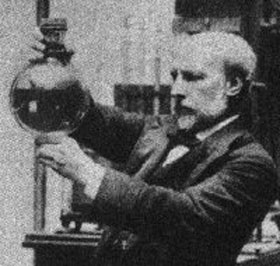| James Dewar  Born: 20-Sep-1842 Born: 20-Sep-1842
Birthplace: Kincardine-on-Forth, Scotland
Died: 27-Mar-1923
Location of death: London, England
Cause of death: unspecified
Remains: Buried, Golders Green Crematorium, London, England
Gender: Male
Religion: Presbyterian
Race or Ethnicity: White
Sexual orientation: Straight
Occupation: Physicist Nationality: Scotland
Executive summary: Researcher of low temperatures British chemist and physicist, born at Kincardine-on-Forth, Scotland, on the 20th of September 1842. He was educated at Dollar Academy and Edinburgh University, being at the latter first a pupil, and afterwards the assistant, of Lord Playfair, then professor of chemistry; he also studied under Kekulé at Ghent. In 1875 he was elected Jacksonian professor of natural experimental philosophy at Cambridge, becoming a fellow of Peterhouse, and in 1877 he succeeded Dr J. H. Gladstone as Fullerian professor of chemistry in the Royal Institution, London. He was president of the Chemical Society in 1897, and of the British Association in 1902, served on the Balfour Commission on London Water Supply (1893-94), and as a member of the Committee on Explosives (1888-91) invented cordite jointly with Sir Frederick Abel.
Dewar's scientific work covers a wide field. Of his earlier papers, some deal with questions of organic chemistry, others with Graham's hydrogenium and its physical constants, others with high temperatures, e.g. the temperature of the sun and of the electric spark, others again with electro-photometry and the chemistry of the electric arc. With Professor J. G. McKendrick, of Glasgow, he investigated the physiological action of light, and examined the changes which take place in the electrical condition of the retina under its influence. With Professor G. D. Liveing, one of his colleagues at Cambridge, he began in 1878 a long series of spectroscopic observations, the later of which were devoted to the spectroscopic examination of various gaseous constituents separated from atmospheric air by the aid of low temperatures; and he was joined by Professor J. A. Fleming, of University College, London, in the investigation of the electrical behavior of substances cooled to very low temperatures. His name is most widely known in connection with his work on the liquefaction of the so-called permanent gases and his researches at temperatures approaching the zero of absolute temperature. His interest in this branch of inquiry dates back at least as far as 1874, when he discussed the "Latent Heat of Liquid Gases" before the British Association. In 1878 he devoted a Friday evening lecture at the Royal Institution to the then recent work of L. P. Cailletet and R. P. Pictet, and exhibited for the first time in Great Britain the working of the Cailletet apparatus. Six years later, in the same place, he described the researches of Z. F. Wroblewski and K. S. Olszewski, and illustrated for the first time in public the liquefaction of oxygen and air, by means of apparatus specially designed for optical projection so that the actions taking place might be visible to the audience. Soon afterwards he constructed a machine from which the liquefied gas could be drawn off through a valve for use as a cooling agent, and he showed its employment for this purpose in connection with some researches on meteorites; about the same time he also obtained oxygen in the solid state. By 1891 he had designed and erected at the Royal Institution an apparatus which yielded liquid oxygen by the pint, and towards the end of that year he showed that both liquid oxygen and liquid ozone are strongly attracted by a magnet. About 1892 the idea occurred to him of using vacuum-jacketed vessels for the storage of liquid gases, and so efficient did this device prove in preventing the influx of external heat that it is found possible not only to preserve the liquids for comparatively long periods, but also to keep them so free from ebullition that examination of their optical properties becomes possible. He next experimented with a high-pressure hydrogen jet by which low temperatures were realized through the Thomson-Joule effect, and the successful results thus obtained led him to build at the Royal Institution the large refrigerating machine by which in 1898 hydrogen was for the first time collected in the liquid state, its solidification following in 1899. Later he investigated the gas-absorbing powers of charcoal when cooled to low temperatures, and applied them to the production of high vacua and to gas analysis. He invented the thermos, which a German firm brought to consumers in 1904.
The Royal Society in 1894 bestowed the Rumford medal upon him for his work in the production of low temperatures, and in 1899 he became the first recipient of the Hodgkins gold medal of the Smithsonian Institution, Washington, for his contributions to our knowledge of the nature and properties of atmospheric air. In the 1920s he performed experiments to measure solar radiation. In 1904 he was the first British subject to receive the Lavoisier medal of the French Academy of Sciences, and in 1906 he was awarded the Matteucci medal of the Italian Society of Sciences. He was knighted in 1904, and in 1908 he was awarded the Albert medal of the Society of Arts. Father: Thomas Dewar (wine merchant, d. 2-Sep-1857)
Mother: Ann (d. Mar-1852)
Brother: Thomas
Brother: Ebenezer
Brother: Robert Menzies Dewar
Brother: Alexander
Brother: Hugh
Wife: Helen Rose (b. 1849, m. 8-Aug-1871, d. 1935)
High School: Dollar Academy
University: University of Edinburgh
Professor: Cambridge University (1875-)
Professor: Royal Institution of Great Britain, London (1877-1923)
British Association for the Advancement of Science President (1904)
Shrapnel Injury Royal Institution laboratory (1886)
Rumford Medal 1894
Matteucci Medal 1906
Davy Medal 1909
Copley Medal 1916
Knighthood 1904
Lunar Crater
Scottish Ancestry
Do you know something we don't?
Submit a correction or make a comment about this profile
Copyright ©2019 Soylent Communications
|